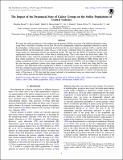The impact of the dynamical state of galaxy groups on the stellar populations of central galaxies
Abstract
We study the stellar populations of the brightest group galaxies (BGGs) in groups with different dynamical states, using Galaxy And Mass Assembly survey data. We use two independent, luminosity-dependent indicators to probe the relaxedness of their groups: the magnitude gap between the two most luminous galaxies (ΔM 12), and the offset between BGGs and the luminosity center (D offset) of the group. Combined, these two indicators were previously found useful for identifying relaxed and unrelaxed groups. We find that the BGGs of unrelaxed groups have significantly bluer near-ultraviolet-r colors than in relaxed groups. This is also true at the fixed sersic index. We find the bluer colors cannot be explained away by differing dust fraction, suggesting there are real differences in their stellar populations. Star formation rates derived from spectral energy distribution (SED) fitting tend to be higher in unrelaxed systems. This is in part because of a greater fraction of BGGs with non-elliptical morphology, but also because unrelaxed systems have larger numbers of mergers, some of which may bring fuel for star formation. The SED-fitted stellar metallicities of BGGs in unrelaxed systems also tend to be higher by around 0.05 dex, perhaps because their building blocks were more massive. We find that the ΔM 12 parameter is the most important parameter behind the observed differences in the relaxed/unrelaxed groups, in contrast with the previous study of Trevisan et al. We also find that groups selected to be unrelaxed using our criteria tend to have higher velocity offsets between the BGG and their group.
Citation
Raouf , M , Smith , R , Khosroshahi , H G , Dariush , A A , Driver , S , Ko , J & Hwang , H S 2019 , ' The impact of the dynamical state of galaxy groups on the stellar populations of central galaxies ' , Astrophysical Journal , vol. 887 , no. 2 , 264 . https://doi.org/10.3847/1538-4357/ab5581
Publication
Astrophysical Journal
Status
Peer reviewed
ISSN
0004-637XType
Journal article
Collections
Items in the St Andrews Research Repository are protected by copyright, with all rights reserved, unless otherwise indicated.
Related items
Showing items related by title, author, creator and subject.
-
SDSS-IV MaNGA: How the stellar populations of passive central galaxies depend on stellar and halo mass
Oyarzún, Grecco A.; Bundy, Kevin; Westfall, Kyle B.; Tinker, Jeremy L.; Belfiore, Francesco; Argudo-Fernández, Maria; Zheng, Zheng; Conroy, Charlie; Masters, Karen L.; Wake, David; Law, David R.; McDermid, Richard M.; Aragón-Salamanca, Alfonso; Parikh, Taniya; Yan, Renbin; Bershady, Matthew; Sánchez, Sebastián F.; Andrews, Brett H.; Fernández-Trincado, José G.; Lane, Richard R.; Bizyaev, D.; Boardman, Nicholas Fraser; Lacerna, Ivan; Brownstein, J. R.; Drory, Niv; Zhang, Kai (2022-07-06) - Journal articleWe analyze spatially resolved and co-added SDSS-IV MaNGA spectra with signal-to-noise ratio ∼100 from 2200 passive central galaxies (z ∼ 0.05) to understand how central galaxy assembly depends on stellar mass (M*) and halo ... -
Secular-and merger-built bulges in barred galaxies
Mendez Abreu, Jairo; Debattista, V. P.; Corsini, E. M.; Aguerri, J. A. L. (2014-12) - Journal articleContext. Historically, galaxy bulges were thought to be single-component objects at the center of galaxies. However, this picture is now questioned since different bulge types with different formation paths, namely classical ... -
Galaxy And Mass Assembly (GAMA) : galaxy close pairs, mergers and the future fate of stellar mass
Robotham, A. S. G.; Driver, S. P.; Davies, L. J. M.; Hopkins, A. M.; Baldry, I. K.; Agius, N. K.; Bauer, A. E.; Bland-Hawthorn, J.; Brough, S.; Brown, M. J. I.; Cluver, M.; De Propris, R.; Drinkwater, M. J.; Holwerda, B. W.; Kelvin, L. S.; Lara-Lopez, M. A.; Liske, J.; Lopez-Sanchez, A. R.; Loveday, J.; Mahajan, S.; McNaught-Roberts, T.; Moffett, A.; Norberg, P.; Obreschkow, D.; Owers, M. S.; Penny, S. J.; Pimbblet, K.; Prescott, M.; Taylor, E. N.; van Kampen, E.; Wilkins, S. M. (2014-11-11) - Journal articleWe use a highly complete subset of the Galaxy And Mass Assembly II (GAMA-II) redshift sample to fully describe the stellar mass dependence of close pairs and mergers between 10(8) and 10(12)M(circle dot). Using the analytic ...

